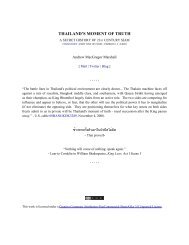THAILAND'S MOMENT OF TRUTH - ZENJOURNALIST
THAILAND'S MOMENT OF TRUTH - ZENJOURNALIST
THAILAND'S MOMENT OF TRUTH - ZENJOURNALIST
Create successful ePaper yourself
Turn your PDF publications into a flip-book with our unique Google optimized e-Paper software.
and shortly after meeting them, invited some student delegates into the palace for an audience. They<br />
emerged to say that Bhumibol had ordered the junta to agree to a new constitution. Most of the protesters<br />
believed they had won, but tens of thousands remained camped around Chitralada Palace overnight, and<br />
the following day, violence erupted. Tanks rolled down Rachadamnoen Avenue, with troops firing on<br />
students; they were also shot at from above, including by Narong himself, from helicopters hovering<br />
overhead. Students commandeered buses and fire engines and tried to ram them into tanks. At least 70<br />
people were killed.<br />
Desperately trying to escape the bloodshed, some students clambered over the walls of Chitralada Palace.<br />
They were given sanctuary by the royal family:<br />
Probably the most important act that symbolically defined the monarchy in Thai politics was on<br />
the morning of 14 October when demonstrators who were beaten by police in the street beside the<br />
palace climbed over the fence seeking refuge inside the palace ground. Then, the royal family in<br />
informal dress came out to meet and expressed sympathy to students. By the evening, the military<br />
junta had been forced out, thanks to a rival faction within the military that gained the upper hand,<br />
and – it is said – to an agreement between the junta and the palace. A grim-faced King Bhumipol<br />
appeared on television and declared 14 October ‘‘the Most Tragic Day’’, and appointed as prime<br />
minister the President of his Privy Council. [Thongchai, Toppling Democracy]<br />
The Three Tyrants fled the country. It was an unprecedented moment in Thai history, the first time a<br />
popular uprising appeared to have succeeded in achieving political change. And as Thongchai argues,<br />
almost paradoxically it was also the beginning of the king’s status as the ultimate arbiter and saviour of<br />
the nation at times of great crisis:<br />
The same moment, then, that gave birth to people’s power and to the opportunity of politicians<br />
in the parliamentary system was also the new beginning for the monarchy in Thai politics. Most<br />
importantly, the king became the higher authority “above” normal politics. But being “above”<br />
politics no longer meant being beyond or out of politics. It meant being “on top of” or overseeing<br />
normal politics. [Thongchai, Toppling Democracy]<br />
Handley describes how the events of October 1974 became a seminal moment in terms of fostering<br />
Bhumibol’s image of a democratic monarch who ruled for the good of the people:<br />
October 14 has ever since taken on legendary proportions, in Thai consciousness and in<br />
Bhumibol's own record. To the students of that and succeeding generations, it was an<br />
unprecedented people's uprising against tyranny...<br />
In official histories, however, it was the king who had single-handedly restored constitutionalism<br />
and democracy. Rather than credit the popular uprising, later books and articles overwhelmingly<br />
emphasized King Bhumibol's intervention against the dictators, saving the country from disaster.<br />
However it was characterized, the October 1973 uprising marked a new zenith in the restoration<br />
of the throne's power and grandeur. [Handley, The King Never Smiles]




